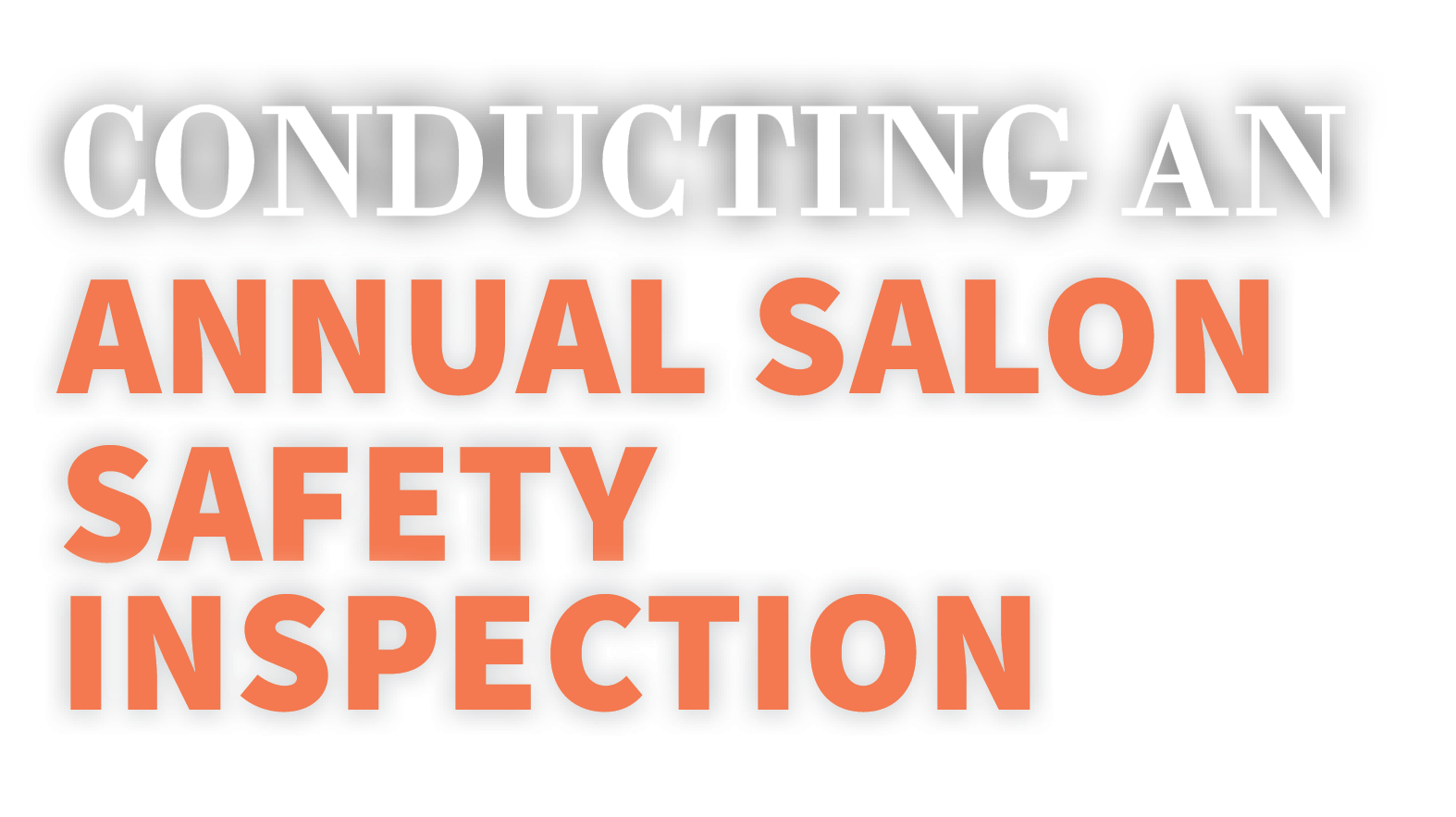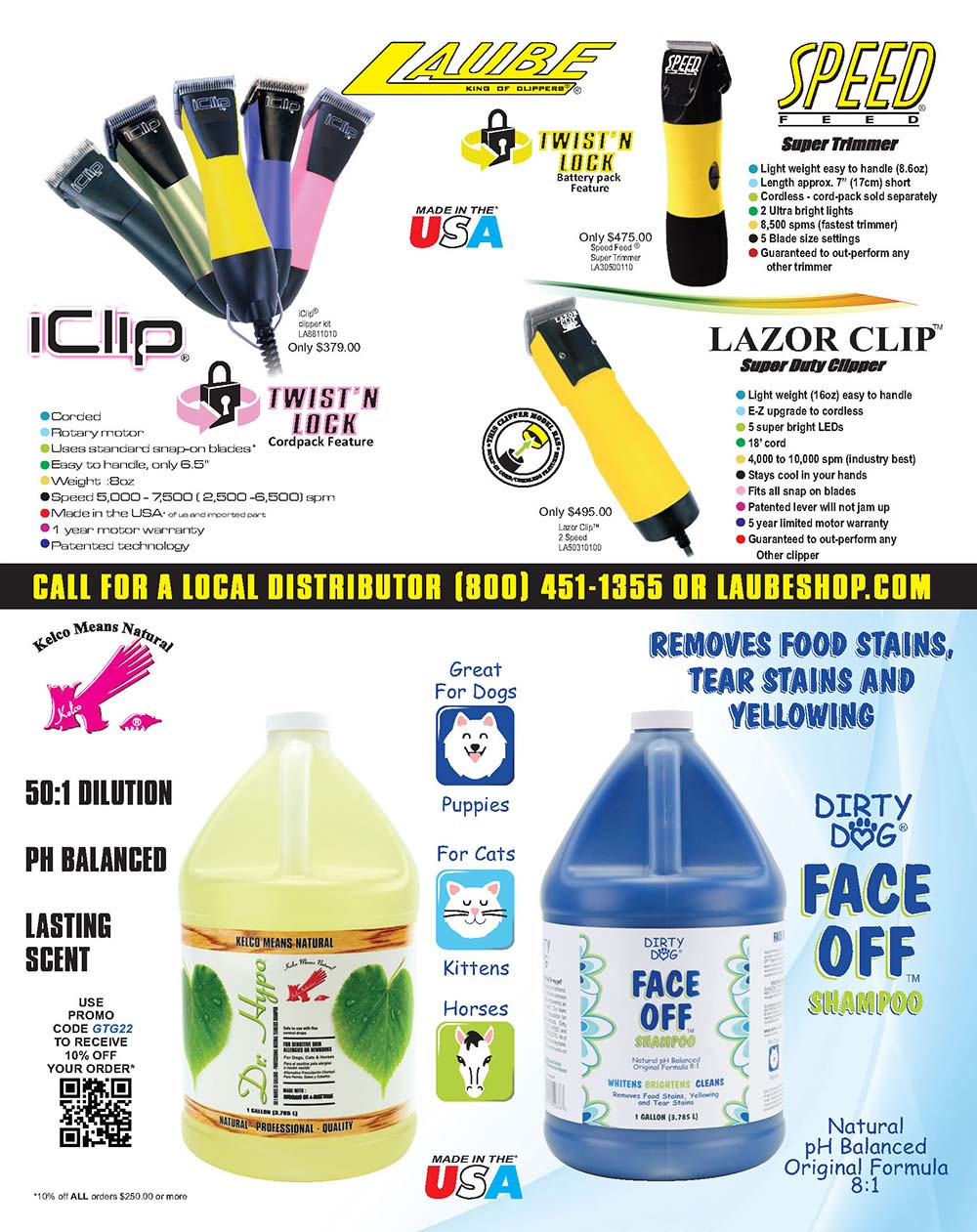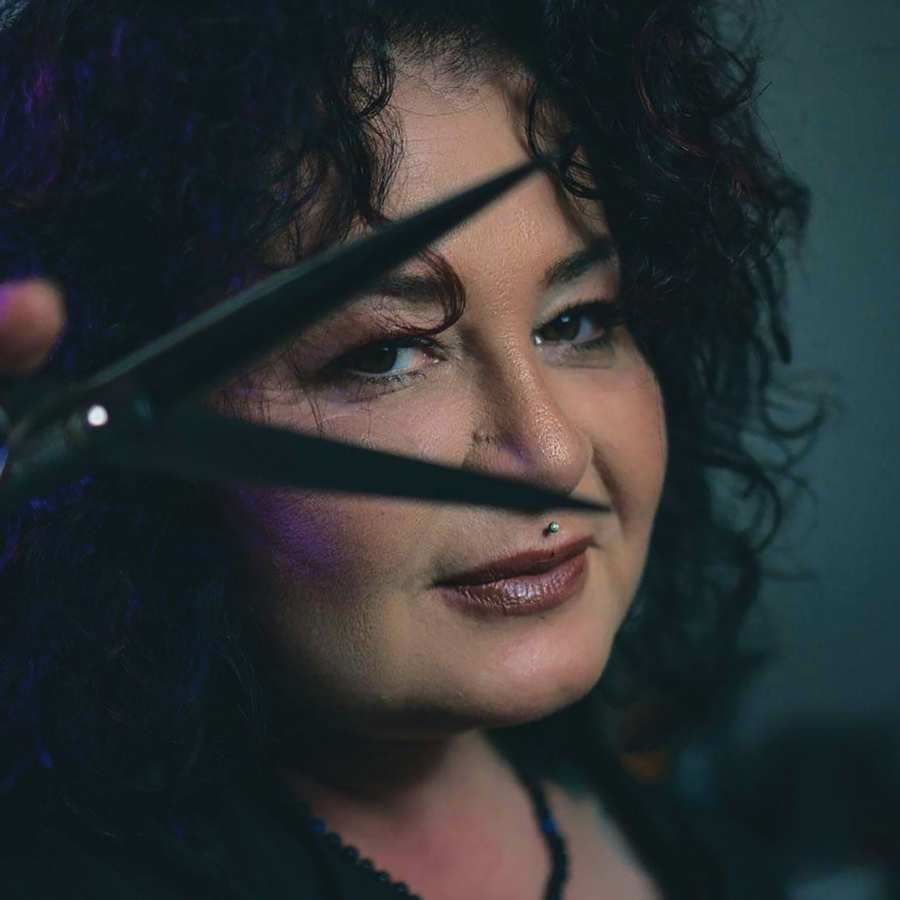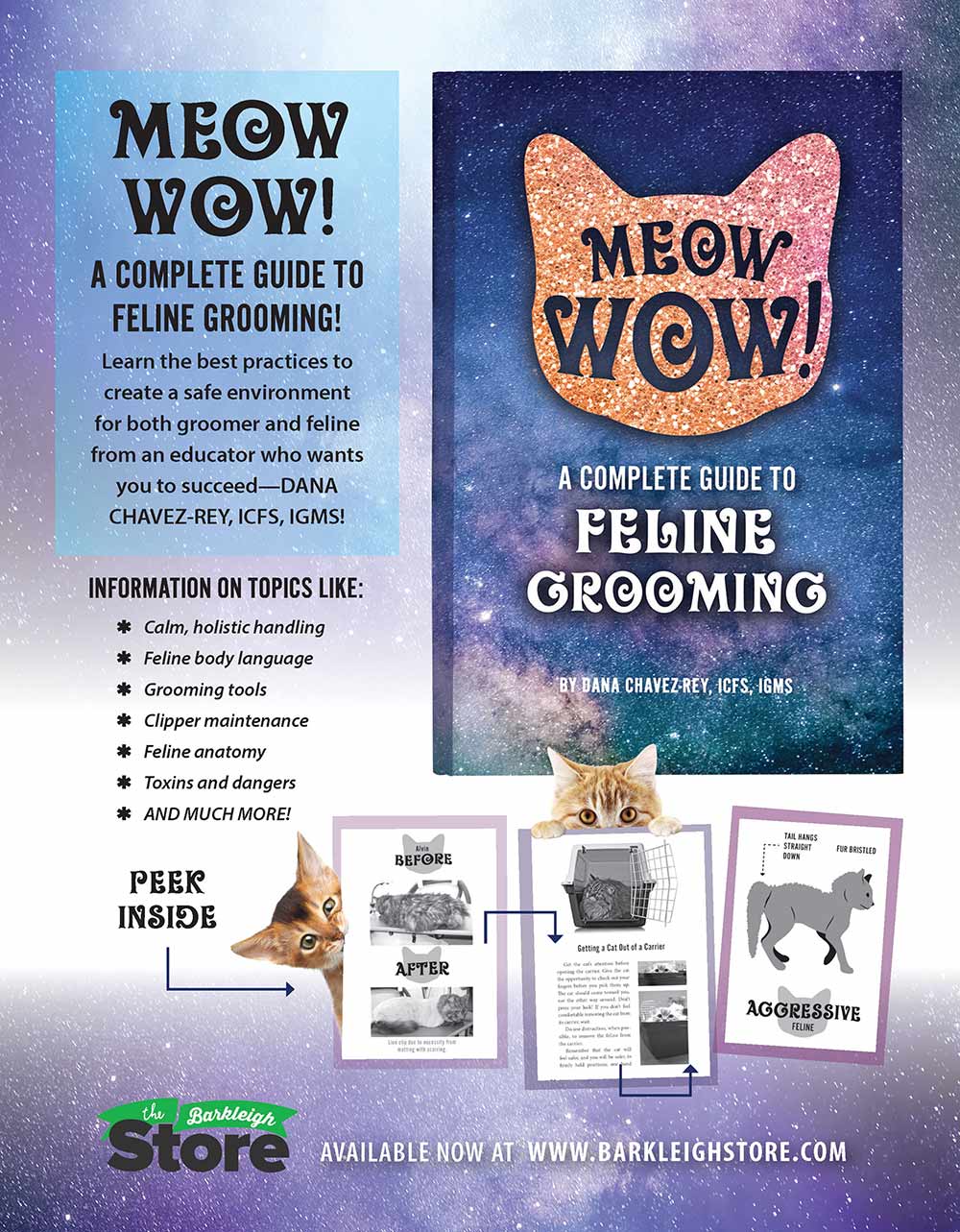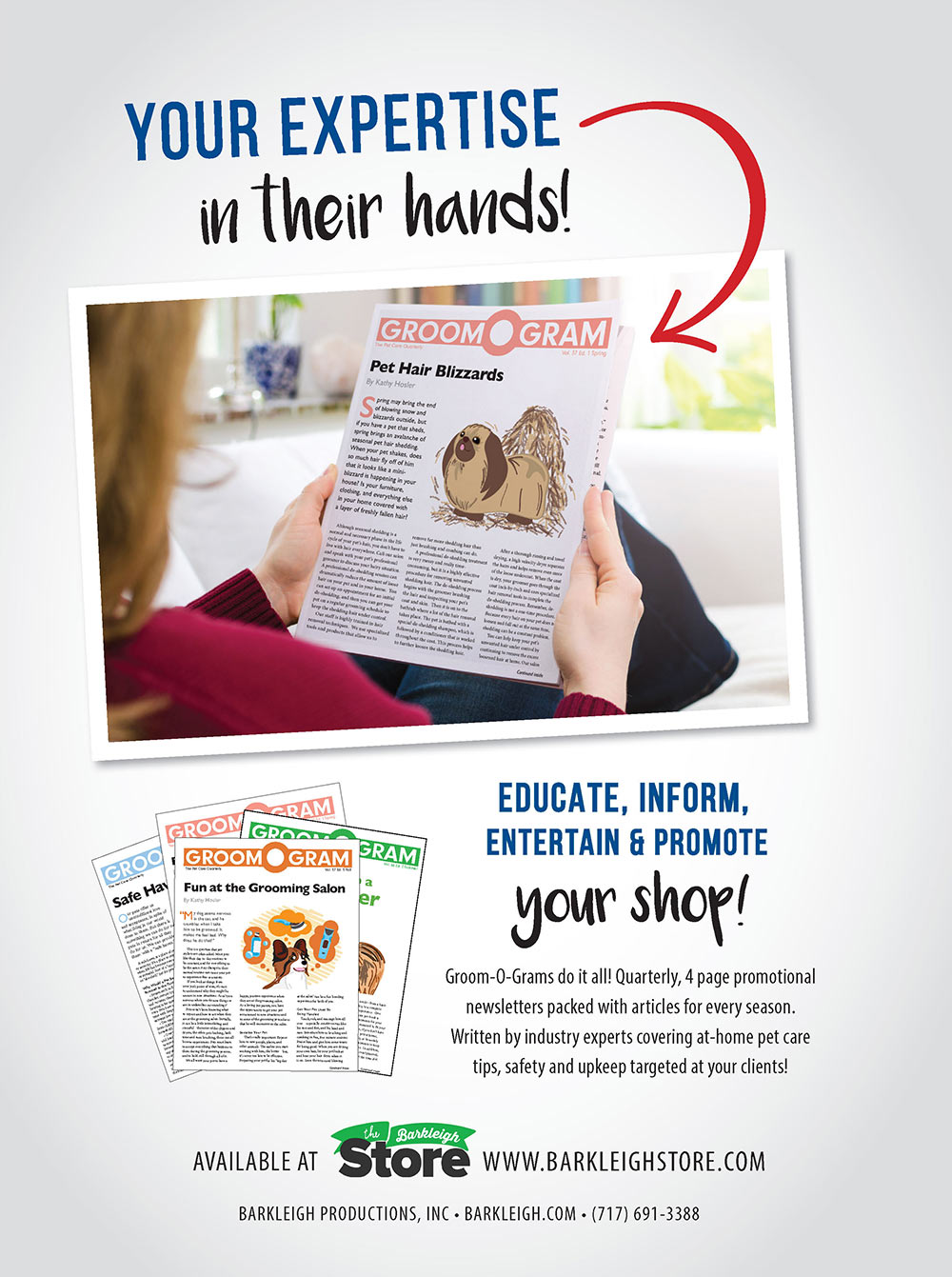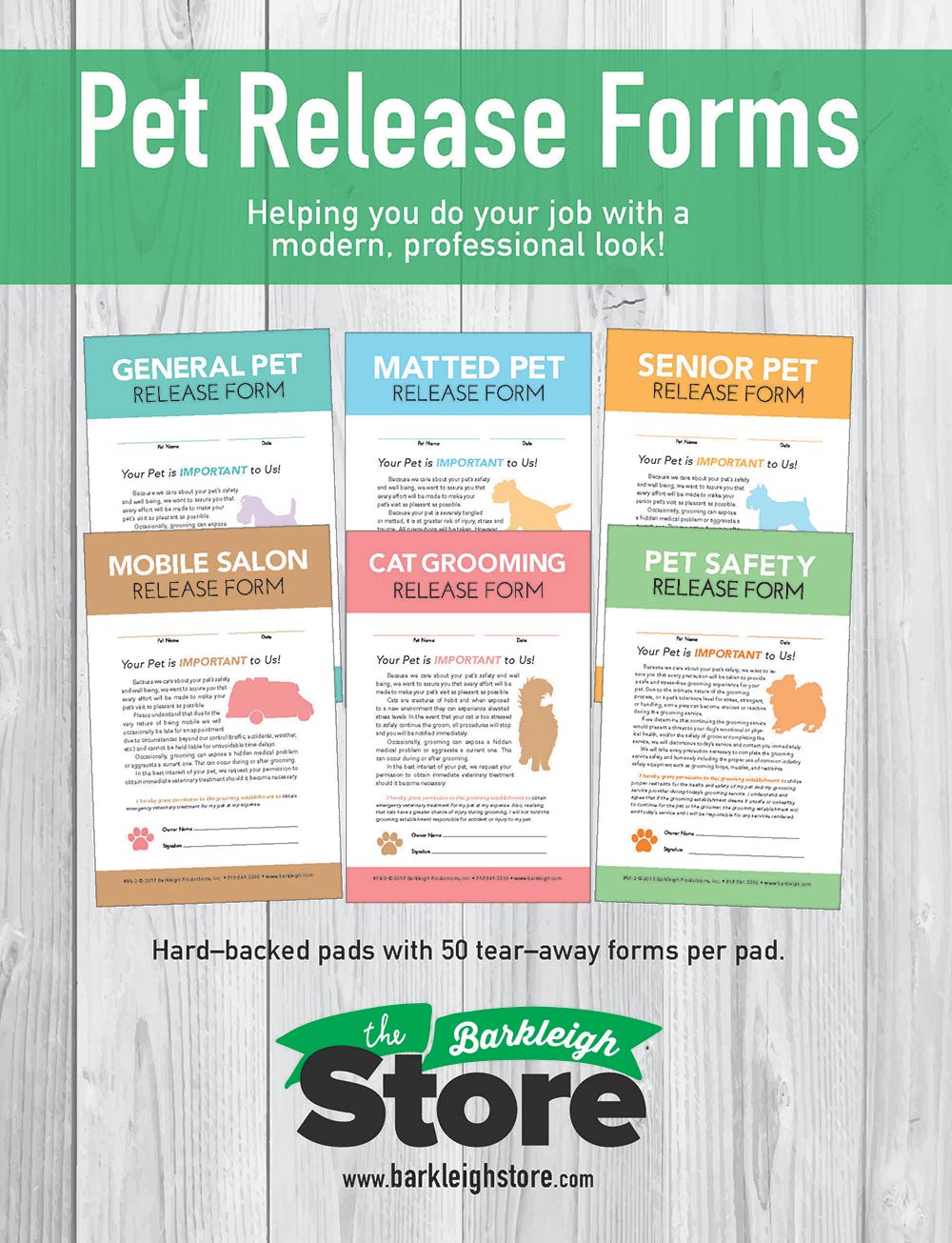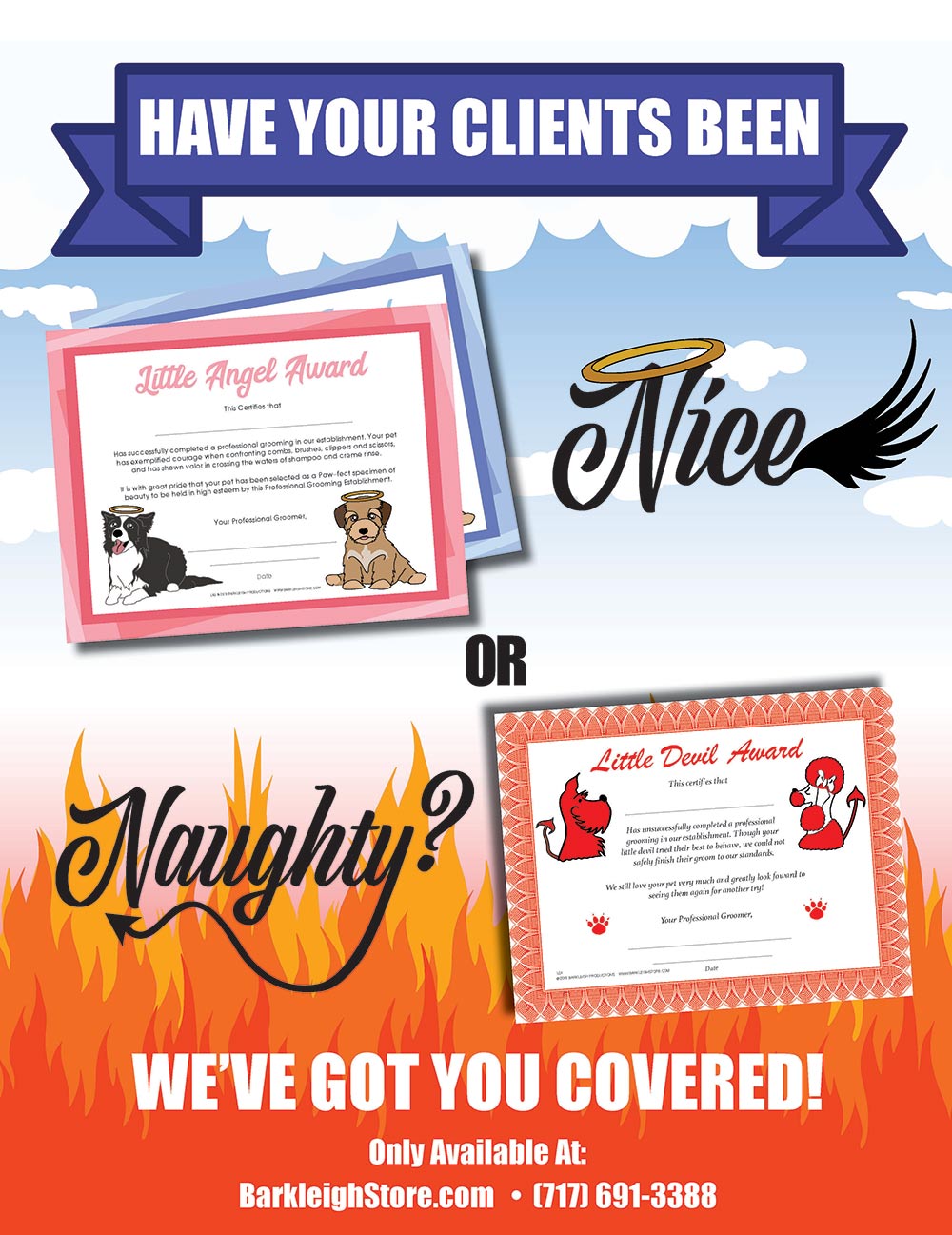



Contents | MAY 2023
by Jennifer Bishop-Jenkins
by Deborah Hansen
ALSO INSIDE
todd@barkleigh.com
adam@barkleigh.com
gwen@barkleigh.com
rebecca@barkleigh.com
luke@barkleigh.com
laura@barkleigh.com
brandi@barkleigh.com
carlee@barkleigh.com
evan@barkleigh.com
cassidy@barkleigh.com
allison@barkleigh.com
james@barkleigh.com
karin@barkleigh.com
britany@barkleigh.com
Daryl Conner
Jonathan David
Dr. Cliff Faver
Blake Hernandez
ALSO INSIDE
ON THE COVER

EXPO WEST 2023 PEOPLE’S CHOICE
CREATIVE SPONSORED BY ANDIS

 eing a pet stylist comes with its own unique set of challenges. No matter how much you love what you do, grooming difficult dogs and crabby cats can sometimes take every bit of strength, skill and patience that you have, and often leaves you exhausted at the end of the day. However, working with pets like these is an absolute pleasure compared to dealing with some of their owners.
eing a pet stylist comes with its own unique set of challenges. No matter how much you love what you do, grooming difficult dogs and crabby cats can sometimes take every bit of strength, skill and patience that you have, and often leaves you exhausted at the end of the day. However, working with pets like these is an absolute pleasure compared to dealing with some of their owners.
Here are a few examples of some unbelievable, but true, unfortunate experiences fellow groomers have had with unruly pet owners…
“I had a very matted pair of ‘little white somethings’ come in,” says veteran groomer Mary Arnold, owner of Bit O’ Blarney Pet Services. “At check-in, I had the owner sign my matted pet release. It has a few lines in it about how the owner *may* have tried to remove mats and unknowingly injured their pet.



 rooming for a living is very different from what most people do. Most people work primarily with inanimate objects or, as I did for three decades as a schoolteacher, they work with other human beings. We are indeed fortunate to do such special work, being entrusted with the care of living dogs and cats. But, with this privilege comes great responsibility to keep these innocent and precious animals safe.
rooming for a living is very different from what most people do. Most people work primarily with inanimate objects or, as I did for three decades as a schoolteacher, they work with other human beings. We are indeed fortunate to do such special work, being entrusted with the care of living dogs and cats. But, with this privilege comes great responsibility to keep these innocent and precious animals safe.

Photo by Anthony Vargas
 rina Pinkusivich, fondly known around the world as “Pina,” is truly one of the most knowledgeable and skilled pet groomers in the world. As a refugee from the Soviet Union, she came to this country with an open mind and a thirst for success—and she found it!
rina Pinkusivich, fondly known around the world as “Pina,” is truly one of the most knowledgeable and skilled pet groomers in the world. As a refugee from the Soviet Union, she came to this country with an open mind and a thirst for success—and she found it!
Pina is widely respected as an expert in the grooming industry, as well as the dog show circuit, and her long list of accomplishments and awards speaks for itself. She has educated pet groomers in every corner of the world, and today she sat down with me to share her incredible journey in the world of dogs…
Jonathan: Hi Pina, you’ve accomplished so much in your career so we have a lot to cover, but let’s start at where it all began. You’ve been working with dogs your entire adult life as a groomer and as a breeder, where did your journey in the world of dogs begin?
Pina: I was 18 years old when my family came to the U.S. as refugees from the Soviet Union. Shortly after that, I won a scholarship to one of the most prestigious schools in NYC so I needed a side job for pocket money. Since I had always been an animal lover, I decided to try and work in that sphere. I found a job at a local grooming salon as a bather and there was only one groomer there. This was my opportunity, so I watched and learned from him for a while. He ended up getting sick, so I then became the main groomer in the salon. After a while, I got burnt out and quit grooming for a couple of years, but I missed it terribly. So, I decided to go back and make it more interesting. During that process is when I first met you, Mr. Jonathan David. You were actually the one to take my interview in the high-end Manhattan salon.

 asked a question on Facebook regarding what topics readers would like me to cover, and the first response I got had to do with organization. I’ll admit to actually vibrating with joy, as this is a skill I’ve learned to master since my natural inclination can only be described as chaos.
asked a question on Facebook regarding what topics readers would like me to cover, and the first response I got had to do with organization. I’ll admit to actually vibrating with joy, as this is a skill I’ve learned to master since my natural inclination can only be described as chaos.
Disorganization wastes time, and time is a commodity that cannot be replaced—only managed effectively. But how exactly does disorganization waste time?
Tasks are forgotten or need to be redone because you forgot a step; time is spent looking for supplies that may or may not be there; money is wasted overnighting supplies which may or not be in stock. All of this and more slows down your ability to get things done.
My secret weapon for organization is my checklists. A checklist is exactly as the name implies—a list of things that need to be checked off. And here’s how they can help you stay organized:


 e have all heard the label “hypoallergenic” when referring to certain dogs, but what does that really that mean?
e have all heard the label “hypoallergenic” when referring to certain dogs, but what does that really that mean?
According to the Oxford dictionary, the definition of hypoallergenic is: relatively unlikely to cause an allergic reaction. And, if you search “hypoallergenic dog” using Google, the results seem endless and the definition ranges from “non-shedding” to “more compatible to people with allergies,” which is quite broad and vague.
My mind wanted to know if there had ever been any scientific research supporting the label of hypoallergenic for dogs or different breeds of dogs. So, in my research, I found a study that had a goal of identifying “whether groupings of dog breeds based on claims of hypoallergenicity influence the accumulation of the major dog allergen, Canis familiaris 1 (Can f 1), levels in homes.” This study evaluated 190 different single-dog-family homes and testing for the Can f 1 dust.
The results from the 2011 study, written in the American Journal of Rhinology & Allergy comparing the levels of dog allergens (Can f 1) in homes with hypoallergenic dogs and non-hypoallergenic dogs,1 found that there was no difference between the two; the levels were the same. They went on to share, “There was no evidence for differential shedding of allergen by dogs grouped as hypoallergenic. Clinicians should advise patients that they cannot rely on breeds deemed to be ‘hypoallergenic’ to in fact disperse less allergen in their environment.”

by Daryl Conner
Day in and day out, we become so accustomed to our work environment that sometimes we miss seeing things we should be paying attention to. It can be easy to “turn a blind eye” to our surroundings, ignoring things that need our attention. However, this can lead to safety issues.
 ne relatively simple way to avoid this is to choose one day a year to perform an annual safety review of our workplace. The first time you do it, be sure to take good notes. The notes can then be turned into a form on your computer that can be easily used as a comprehensive checklist in the future.
ne relatively simple way to avoid this is to choose one day a year to perform an annual safety review of our workplace. The first time you do it, be sure to take good notes. The notes can then be turned into a form on your computer that can be easily used as a comprehensive checklist in the future.

 hen I first started grooming, I was worried about educating my clients on at-home grooming. My concern was that if I taught cat owners how to comb out their cat or clip their cat’s nails, they would no longer need my services or see the value in my grooming skills or business. However, time has shown me that nothing is further from the truth! In fact, the more I educate owners, the better they are at scheduling their cats for grooming before there is a problem.
hen I first started grooming, I was worried about educating my clients on at-home grooming. My concern was that if I taught cat owners how to comb out their cat or clip their cat’s nails, they would no longer need my services or see the value in my grooming skills or business. However, time has shown me that nothing is further from the truth! In fact, the more I educate owners, the better they are at scheduling their cats for grooming before there is a problem.
Someone once told me that grooming their own cat was a chore, and people always prefer to hire out chores when possible. Think of a car wash: Almost everyone owns a vacuum, hose and some rags, yet most people prefer to go to a carwash and pay someone else to clean their vehicle for them. The same is true for cat grooming. Even those with the knowledge and equipment to groom their own cat often prefer to have someone else take care of the chore of grooming their beloved family member.

scary truth that most of us don’t want to face is that we are exposed to some pretty nasty stuff working in the animal industry. Having said that, most of us much prefer dealing with animals rather than humans in the same situation. A big difference though is that the level of hygiene we practice with humans is usually much more thorough than what we practice with animals. Does that make sense though?
We should always be mindful of areas of high risk and work to minimize them. For example, when was the last time you changed the air filters on the vacuum or HVAC unit? When was the last time you disinfected the mop, the towels or the hoses to your recirculation bathing system? Are you cleaning all your equipment—tubs, cages, etc.—between every pet? Every one of us takes a stab at this, but is what we are doing truly adequate?

 he Bolero in any variation just screams retro! It is a very old-looking style, and those who have been grooming for over two decades probably remember it fondly.
he Bolero in any variation just screams retro! It is a very old-looking style, and those who have been grooming for over two decades probably remember it fondly.
The dog used here is six weeks grown out from a clip and scissor Modern trim with the feet, face and tail base already shaved.
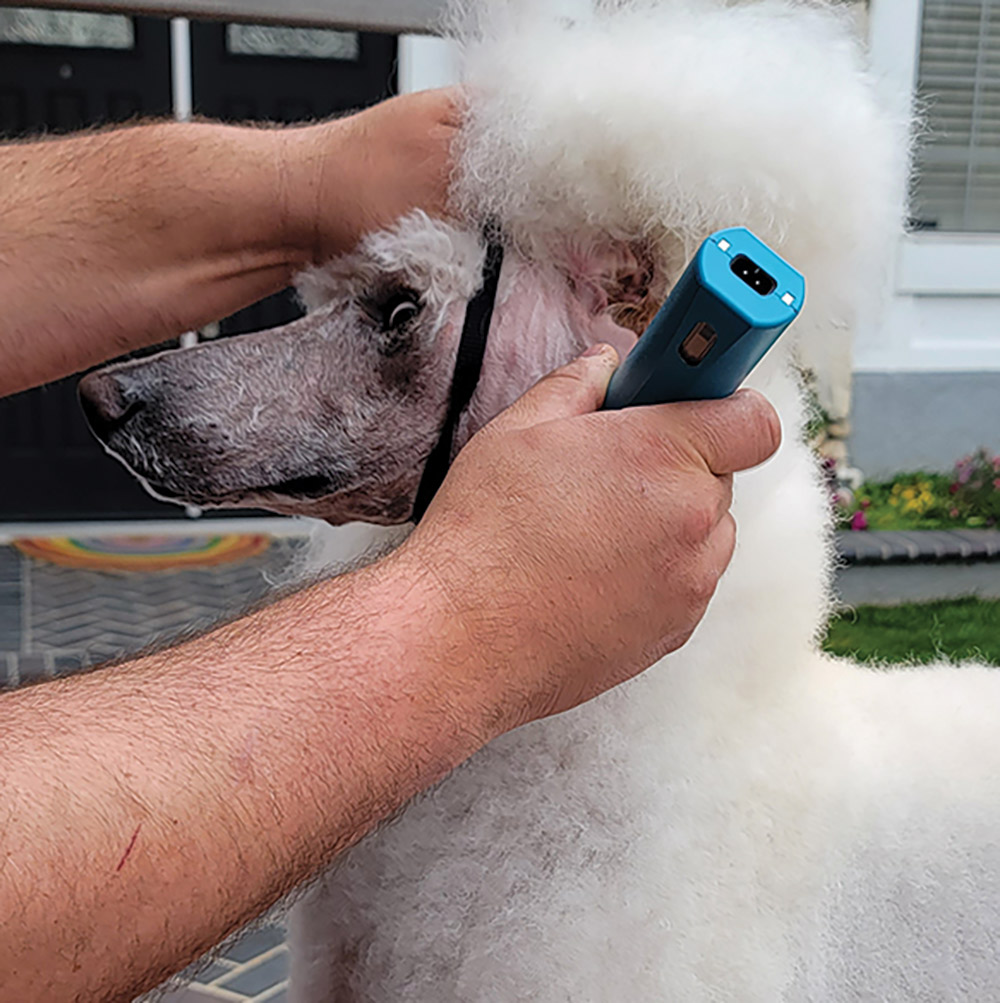




 aleska is a lovely, exuberant and silly Doberman who always gets her nails painted each month in something seasonally appropriate, and she enjoys it perhaps a bit too much…
aleska is a lovely, exuberant and silly Doberman who always gets her nails painted each month in something seasonally appropriate, and she enjoys it perhaps a bit too much… “OK, you’re all clean and conditioned. Let’s head to the table and get you dried and finished,” I tell her.
“OK, you’re all clean and conditioned. Let’s head to the table and get you dried and finished,” I tell her. Valeska: “And nails! We do nails first!”
Valeska: “And nails! We do nails first!” “No, we can’t paint your nails first, nail painting is always last,” I
“No, we can’t paint your nails first, nail painting is always last,” I
remind her. Valeska: “No, this time we do it first!
Valeska: “No, this time we do it first! “We can’t do it first. When I brush you, all of your fur will stick to the wet nail polish,” I say.
“We can’t do it first. When I brush you, all of your fur will stick to the wet nail polish,” I say. Valeska: “Skip that part.”
Valeska: “Skip that part.” “That’s why you’re here, I’m not skipping that part!” I tell her.
“That’s why you’re here, I’m not skipping that part!” I tell her. Valeska: “Don’t need brushing, just nails pretty.”
Valeska: “Don’t need brushing, just nails pretty.”



Best in Show

BEST ALL AROUND
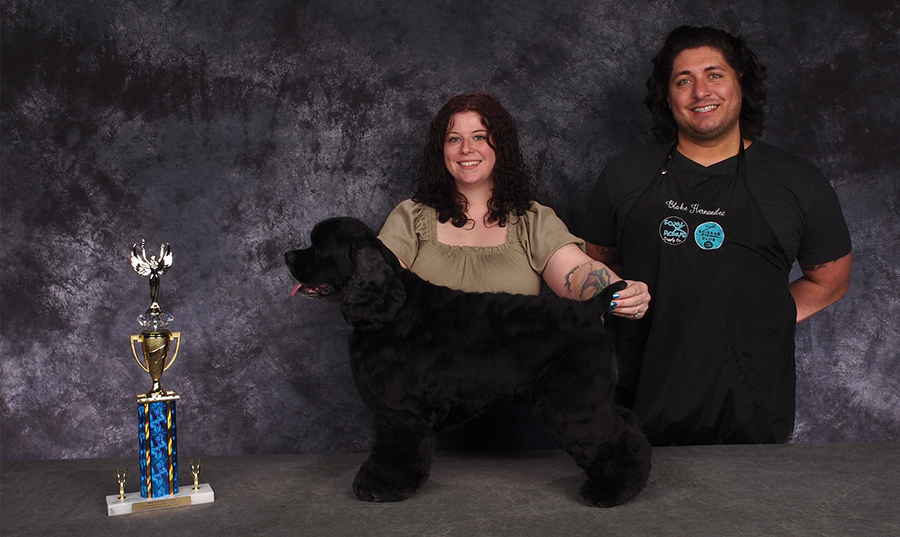
BEST FIRST TIMER





